OBSERVING METEORS - THE LEONIDS
Last updated: 24 October 2001
OBSERVING METEORS - THE LEONIDS |
GETTING READY FOR THE 2001 LEONID METEOR SHOWER
Could This Be the Meteor Shower of the Millennium?
From: sherrodc@ipa.net (Clay Sherrod)
If you read no farther, READ THIS: mark your calendars for the dates of November 17, 18 and 19th.
If you remember to check that calendar, then you might well witness what many astronomers are calling the possible "Meteor Shower of the Millennium," the return of the fabulous Leonid meteor shower as the Earth passes once again through the very dense central portion of the debris cloud left in the wake of Comet Temple-Tuttle of 1866.
Leonid meteors can be seen every November, usually about the 17th or 18th in numbers that can reach perhaps a hundred visible meteors to the naked eye each hour. However, every 33 years the Earth passes very close to the densest portion of the comet cloud and hence the meteors seem to increase at that cycle. The greatest display perhaps of this tremendous event occurred during the 1833 pass when observers throughout New England, to Florida and even as far south as explorers in the mountains of Venezuela. The old lithograph copied below is from an unknown artist who rendered his hand of the event as seen over a relatively-new United States landmark of Niagara Falls.
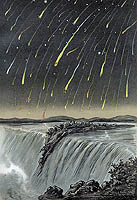
Indeed, in this year of 1833 the intensity was so great that the general population was in great fear from this "....night the stars fell from the sky. The meteors - just as they will do on November 17, a Saturday night and into the following Sunday morning - began to appear in sparse numbers during the late evening hours on that date, and gradually began to increase; however, the storm itself - perhaps over 50,000 per hour visible to the naked eye! - began suddenly and without warning at which time, the famed explorer and astronomy von Humboldt exclaimed that "......they [the Leonids] fell like snowflakes from the sky...." as he watched them from what must have been incredibly dark skies atop the remote mountains of Venezuela on this moonless night.

---------------------------------
WHAT IS A METEOR?
To refresh on "meteor terminology," let us quickly review the correct word associations for the upcoming event. Of course we are all familiar with the phrase "shooting star," but thank our lucky stars that STARS do NOT randomly fall from the sky. As the point of light seems to suddenly increase in brightness and move across the sky in lightening speeds, it does indeed appear to be a star that is rapidly in motion, leaving a fiery wake behind it. But "shooting star" is merely a misnomer for the phenomenon we know today as "meteor." It is one of three "names" associated with this phenomenon:
METEOROID: an object - usually dust to grapefruit size - that remains as debris from a disintegrating comet in its wake; this meteoroid will follow in essentially the same path as the comet, and thus many times encounter the earth in periodic fashion, just like the debris from Halley's Comet comes in contact with the Earth in October as the Orionid meteor shower and again in spring as the Eta Aquarid meteors. The objects following in the path of Comet Temple-Tuttle are meteoroids until they encounter the Earth's atmosphere.
Compare the two photographs of Halley's comet following, BOTH taken simultaneously on March 14, 1986; the first one I took with a 400mm Nikkor f/3 lens and camera riding piggyback at the observatory for 20 minutes showing the dust and gas tail of the comet when near brightest; it is from this decaying material that largely comprises the tail that many of our meteoroids originate. Now look at the close-up from the European Space Agency spacecraft as it rendezvoused with Halleys on the same night; you can see the solar wind actually eating away at the comet's nucleus, release much dust and debris that can possibly eventually collide with the Earth in October or May of some year in the resulting form of "Meteors."
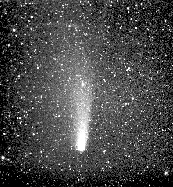
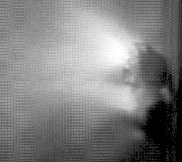
METEOR: when the meteoroid and Earth intersect, the particles hit the Earth's atmosphere with such velocity (many miles per second) that they ignite from the friction and typically will burn up; only slower-moving meteors and those of larger size can survive the fiery plunge to Earth and remain somewhat intact. The phenomenon of the Temple-Tuttle meteoroids hitting and burning in the Earth's atmosphere is known as the LEONID METEORS. The Leonids are among the fastest of all known meteors and fly through the sky very swiftly and are bright white and yellow due in large part from this rapid clip through the air.
METEORITE: any meteor which can survive this fiery plunge through the dense air of Earth and actually make it to the ground is known as a METEORITE. The Leonids meteors are so fast and for the most part so small that they rarely will survive the descent, and few if any meteorites found on Earth can actually be associated to the Leonid cloud.
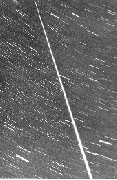
This photograph shows a very bright (magnitude -4, about the brightness of Venus) meteor, or "bolide" as it streaks across Arkansas skies in 1975; this photograph was taken with a regular 50mm camera lens at f.1.7 and focused to infinity; the camera was fixed on a tripod for this 20-minute time exposure. The shot ended as soon as I knew I had captured the meteor in my camera's field of view. Viewers are encourage to use their cameras for such shots; both 35mm and digital cameras are suitable provided that you have a TIME or BULB setting and that the lens is focused to infinity. Mounting on a tripod or piggyback on a telescope is essential. Remember that if your camera is digital or has an electronic shutter, the battery life will drain quickly during long exposures.
-----------------------------
WHAT TO EXPECT
The Leonids pretty much "fizzled" for the expected pass in 1998-99. This was in spite of a greatly anticipated 33-year return after the spectacular 1966 event when an estimated 150,000 meteors per hour might have entered the atmosphere! In 1999 the astronomical world was waiting with lens caps removed, special wide field cameras and video equipment and even specialized instruments that could measure temperatures, velocities and even chemical elements that might be present in the vaporizing trails of the meteors.
But it didn't happen...at best, astronomers rated the 1998-1999 Leonids as "moderate." But the peak actually occurred 18 hours ahead of predictions and - for most of the civilized and populated world - unfortunately during daylight hours. In addition, it appears that the Earth bypassed the more numerous and smaller meteoroids, and instead ran headlong into a very sparse scattering of LARGER particles that are theorized to have broken off of Comet Temple-Tuttle way back in A.D. 1333!
For 2001 the prognosticators of celestial events are all pretty much in agreement for a very fine - if not spectacular Leonid meteor shower for North America (particularly states west of the Mississippi River), the Pacific islands and an even more splendid showing for easternmost Asia and Australia/New Zealand.
An unusual aspect of this meteor shower is that the Earth will receive a "double punch" as it hits not one, but TWO, pockets of very dense interplanetary debris! The first hit (Phase One) will be the ideal observing scenario for North America and occurs a full eight (8) hours ahead of the LARGER display (Phase Two) which will peak in dark skies over Japan, the Philippines, eastern China and the Australia-New Zealand area.
I am predicting the following activity based on models set up by astronomers worldwide, and suggesting that this is a two-phased event, the second of which - visible to our observers is New Zealand, Australia, Japan and the western Pacific islands - will be up the THREE TIMES the incredible intensity of the first!
Phase One: North America, Western States More Favorable In the earliest pre-dawn skies of Sunday, November 18 for most of North America the Earth will be going through the MAXIMUM concentration of cometary dust around 5:00 a.m. EST. However, darkness will prevail longer the farther WEST that observers are located on this continent, so many observers are planning excursions to the clear and crisp mountain skies of the western United States. I strongly suggest that you prepare to begin observing NO LATER THAN 1:30 a.m. on Sunday morning, November 18.
For North America the maximum number of meteors - perhaps as many as 3,000 PER HOUR - will be seen further into pre-dawn hours as one moves west. It will be an hour earlier - 4:00 a.m. CST - when the Earth passes through the dense comet cloud in central states, 3:00 a.m. MST in the Colorado Rockies, 2:00 a.m. on the west Coast for our California, Washington and Oregon observers. Phase One will be a very rapid-fire brief burst of meteor activity; as mentioned, the Leonids are among the fastest known, and they will be intersecting the Earth nearly head-on into its orbit. Thus, most meteors seen will flash rapidly across the sky and NOT linger....the meteors are typically faint compared to the brighter and slower Perseids of August. Look for the greatest activity to suddenly surge about one hour ahead of the times given above. This earliest phase of the Leonids will last about two hours total.
Phase Two: Australia, New Zealand, Indonesia, Japan, western Pacific Observers in the western Pacific are "on the other side" of the International Date Line, and thus, the western Pacific rim is much favored for the "second punch" of the meteors against the Earth's atmosphere. This impact with yet another dense cloud following Comet Temple-Tuttle will occur a full eight hours later than that seen in North America, or in pre-dawn skies of November 19. Estimates range upwards to many thousands of Leonids visible beginning at about 3:30 a.m. November 19 in eastern Australia and New Zealand. The same display might be seen at about 2:30 a.m. local time in Japan and as early as 1:30 a.m. in the Philippines and western Australia.
For observers in this Phase Two zone, this display is predicted to be the finest meteor shower since the Leonids of 1866.
------------------------------
HOW TO OBSERVE THE LEONIDS
Like eating a "Reese's Peanut Butter Cup", there are more than one way to watch the Leonids or any meteor shower. The two most popular are: a) sit back and relax....enjoy the show!; and, 2) sit back and record your observations....enjoy the show!
For the latter, there are a few ways whereby you might actually contribute even casually to the science of "meteor wisdom" and at the same time preserve these memories via your SLR 35mm, video, or basic digital camera. Following is a quick and easy checklist and observing guide for you to enjoy and capture this celestial event that is sure to not return "at least" until 2033.
1. KNOW THE TIME: Based on your location and the predicted times given above, don't take any chances; set your clock two hours early (the predictions might be off a bit!) and go outside prepared! Remember, for North American observers, begin your watching about 1:30 a.m. at which time there will be a few early meteors.....we never know for sure exactly when the big hit will occur. So......how about staying UP all night and use this wonderful opportunity to get acquainted with the wonders of the night sky?
2. KNOW WHAT TO LOOK FOR: The Leonids appear to enter the Earth's atmosphere toward the direction of the bright star Gamma Leonis in the conspicuous constellation of Leo (refer to the observing chart below). This "radiant" is the point at which the Earth in its eastward motion plunges into the meteoroid cloud. Use the star magnitudes (brightness's - the smaller the number, the brighter the star or meteor) given on the chart to estimate your sightings of as many meteors as possible. The naked eye can see stars as faint as about 6th magnitude on a very dark and moonless night. The constellation and radiant will rise in the eastern sky about midnight local time and will be nearly overhead (for North American viewers) near dawn.
However! It is important to note that the most meteors will NOT be seen in the direction of the radiant, but more often about 30 degrees and more away from it as the meteors are pulled deeper into the Earth's atmosphere the farther they travel. I strongly suggest that observers merely look pretty much directly OVERHEAD to see the maximum number of meteors! This "aiming rule" also applies to your camera's field of view as well.
Note that on the following Leo chart (showing only the brightest stars of the constellation) that the star magnitudes are provided, as well as the approximate location of the meteor shower "radiant." The common Arabic names of the bright stars are given for reference. The brightest star in the constellation is known as "Regulus", the "heart of the lion" while the "tail star" is that marked as "Denebola." The bright star ALGIEBA, above which the Leonids appear to radiate, is a very spectacular "double star" which is known by observers with small telescopes to appear as "...two car headlights far down a distant highway!"
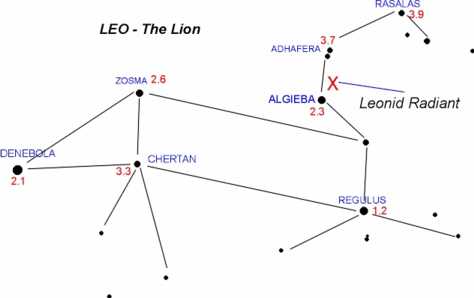
Remember that the MOON will be absent during the 2001 showing of the Leonids and you should take full advantage of this opportunity; since the Leonids are intrinsically faint anyway, the darker the skies, the more meteors per hour (the "Zenith Hourly Rate," or ZHR) will be seen by each observer.
If there are several observers in your group, then orient each observer such that each is looking in a slightly different direction yet some overlap of sky coverage must occur. Each observer will count his or her own meteors beginning at about 15 minute intervals....do not combine the totals for a ZHR.....just add them up and divide by the number of observers to determine a "mean ZHR."
3. DECIDE WHERE YOU WILL OBSERVE: Be sure to plan this night carefully! Do NOT plan to observe from the city nor suburbs! Part of that planning MUST be from where you will observe to realize the darkest possible skies to see the faintest meteors.....but don't wait until that night to find a dark site. Plan to go out to your observing location on a night and time prior to the event and make sure that there are no bright "nightwatcher" lights that will interfere with your observing! If you live in a rural location it is likely that merely going into your own yard to watch the meteors will be fine; however, most "city" observers should attempt to find a very dark sky site to make the most of these relatively faint and fast meteors.
4. KNOW HOW TO OBSERVE: this is a really hard part: take out a comfortable reclining lawn chair and a blanket....position yourself with your feet toward the EAST (toward the Leo radiant), and position yourself comfortably so that you are looking directly overhead! Such conditions are so strenuous that many, many observers have missed entire meteor showers as they nodded off in celestial bliss.
5. THINGS TO RECORD: to make the event even more meaningful, there are few minor details that you may want to record: a) the time at 15-minute intervals and the number of meteors that EACH person sees during that short interval; this will allow you to compute for yourself and your location about when the actual peak occurs; b) the color of the meteors; this is an indicator of both the temperature and the speed of each meteor; c) directions of travel; although the radiant position is well known, this is an interesting exercise....merely attempt to trace your brighter meteors backwards in their pathways and you can determine for yourself via the chart above a rough idea of the radiant from your own observations!
6. PHOTOGRAPHING THE LEONIDS: as mentioned the Leonids are fairly faint and fast for the most part; however there ARE members that will be extraordinarily bright and these can be recorded on a standard camera (35mm SLR with a "bulb" or "time" setting), a digital camera that can allow exposures of up to 16 seconds, and a videocamera. For all types, a tripod is required and a cable release is recommended for time exposures for the still cameras. Use ASA 400 speed film or faster with your 35mm camera, set your lens aperture "wide open" (f1.8 or similar) and expose for at least five minutes; the stars will trail in these photographs (as you can clearly see in the 15 minute photo taken to record the bright fireball above) from the Earth's eastward rotation. With your digital camera, merely take sequences of photographs that extend as long as the time exposure setting will allow, and use the widest angle setting and aperture possible. Video camera users can capture the brightest meteors by simply "zooming out" to wide angle and allowing the camera to run continuously. Your best chances of "catching" a meteor with cameras will be through aiming the camera straight up, or alternative between that position and somewhere halfway from overhead to the southern horizon.
7. WHAT TO DO WITH YOUR OBSERVATIONS: if you catch a spectacular fireball, by all means submit your photograph to this web site! For ZHR counts and other important information that can add to the body of knowledge of our understanding of meteors and their parent comets, you can submit you records (keep a copy!) via e-mail to: http://www.amsmeteors.org/ which is the American Meteor Society, a large world-wide group formed and continuing to add to the growing studies of meteors, comets and related phenomenon.
-----------------------------
This is an excellent time to take the family and friends on a weekend outing into the dark and cool nights of fall. Find a quiet and restful place far from home, far from the lights and cares of the "big city," and enjoy the wonderful skies filled with the smells of impending winter, the sounds of the cold autumn blasts of artic air and the glorious sights of the winter Milky Way as it pours through constellations of antiquity. Through the bright stars of Canis Major and Orion.....across the blanket of sky that passes behind the stars of Taurus and its visitor Saturn....into the depths of Gemini and the interloping Jupiter.....
....they will await you: the 2001 Leonid meteors. This may be YOUR meteor shower of the Millennium.
P. Clay Sherrod
Arkansas Sky Observatory
Conway / Petit Jean Mountain
Arkansas
Return to the top of this page.
Go back to the Observational Guides & References page.
Go back to my ETX Home Page.